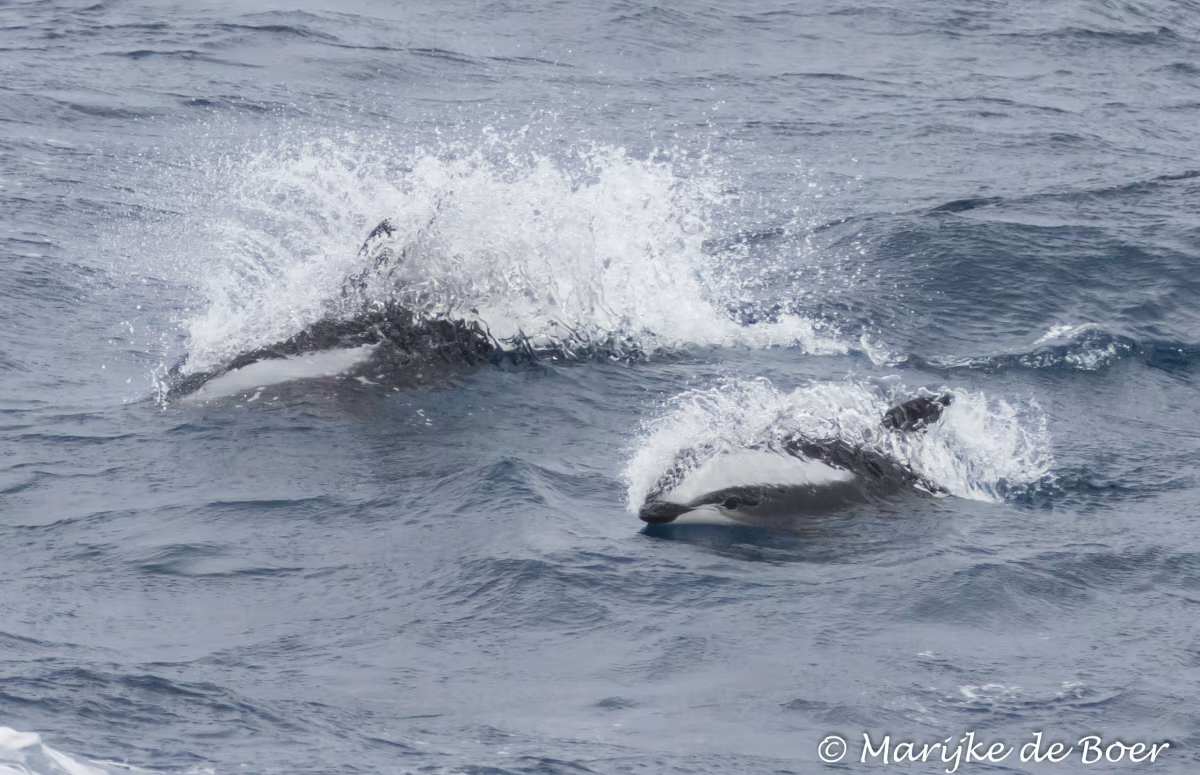Name: Sea cow, sea skunk, Wilson’s dolphins, southern right-sided dolphins (Lagenorhynchus cruciger)
Length: 1.8 meters (5.9 feet)
Weight: 90 kg (200 pounds)
Location: Antarctica, sub-Antarctic Islands, Drake Passage
Conservation status: Least concern
Diet: Fish, squid, crustaceans, worms
Appearance: White belly, black top, white side patches sometimes with dark gray variations. Two white flank patches: one above the beak, eye, and flipper; a second at the rear. These patches are connected by a white strip, creating an hourglass shape from which the dolphin gets its name.
How do hourglass dolphins feed?
Hourglass dolphins use echolocation for orientation and prey location. A recent study showed they produce clicks that allow them to detect prey at more than twice the distance of other dolphin species.
Feeding on lanternfish, squid, and crustaceans, hourglass dolphins have been spotted feeding in groups of seabirds and plankton swarms. They have conical teeth: 26 - 34 in their upper jaws and 27 - 35 in their lower jaws.

Picture by Hans Verdaat
Are hourglass dolphins social?
Not much is known about the social or parental behavior of hourglass dolphins, and their juveniles are even less frequently observed. In a recent study, only three calves were identified out of a group of 1,634 hourglass dolphin adults.
Scientists think this low number may be due to hourglass dolphins breeding during winter, when harsh weather prevents detailed studies, but it may also be due to the tendency of hourglass dolphins to avoid vessels.
How fast do hourglass dolphins swim?
Hourglass dolphins have been observed swimming at speeds of 22 kph (14 mph).
What are hourglass dolphin birthing rituals like?
The breeding rituals of hourglass dolphins are relatively unknown, probably because this species breeds in winter.

Picture by Marijke de Boer
How long do hourglass dolphins live?
Like their breeding routines, not much is known about the lifespan of hourglass dolphins. They probably live between 30-45 years in the wild, comparable to certain other dolphins.
How many hourglass dolphins are there today?
Researchers estimate there are about 145,000 hourglass dolphins.
Do hourglass dolphins have any natural predators?
There is no documented evidence, but it is thought orcas might prey on hourglass dolphins as on some other marine mammals. Hourglass dolphins have never been hunted commercially.

Picture by Meike Sjoer
Five follow-up hourglass dolphin facts
- The Latin name of hourglass dolphins, cruciger, means “cross-bearing,” referring to their distinctive cross-like pattern when seen from above.
- Hourglass dolphins were once known as sea skunks or sea cows, due to their black-and-white coloring.
- Identified in 1824 by Joseph Paul Gaimard and Jean René Constant Quoy from a drawing done four years earlier in the South Pacific, the hourglass dolphin is thought to be the only cetacean accepted as a species based on witness accounts.
- Hourglass dolphins are not only known for their unique coloring, they are also the only dolphin with dorsal fins south of the Antarctic Convergence.
- As of 2010, fewer than eight hourglass dolphins had even been studied.
Main image by Andrew Crowder
